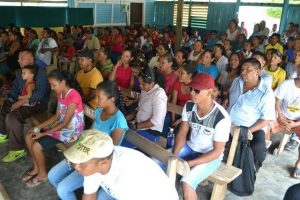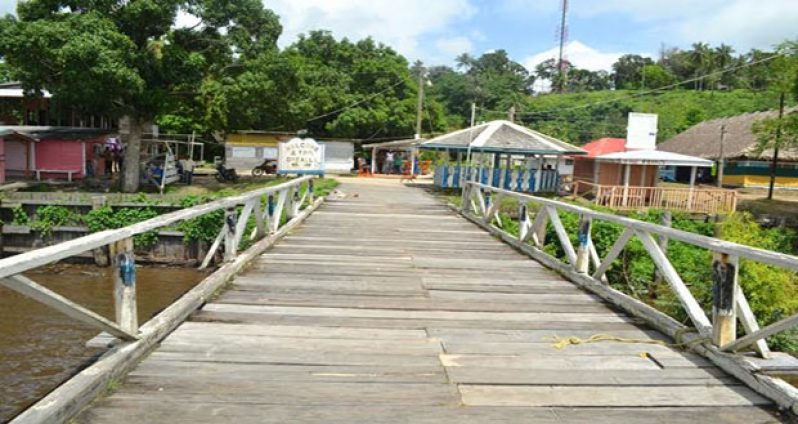LOCATED on the Corentyne River, Orealla or Orealla Mission can be found approximately 50 miles South of Crabwood Creek on the Corentyne Coast in Region Six. This community overlooks neighbouring Suriname.The pathway to this Amerindian reservation and its satellite, Siparuta, starts from Georgetown, where one has to travel by road to Crabwood Creek, and thereafter by boat for approximately three hours before arrival at Orealla.

Orealla is an Arawak word which means “white chalk”, and seems to have acquired its name from the surrounding chalk hills. Orealla was at one time inhabited mainly by the Arawaks and Warraus with some Caribs, but at present, Wapishanas and Macushis can also be found there.
Orealla and Siparuta are the only two Amerindian reservations on the Corentyne River. These villages are structured locally as one and are managed by a Toshao (Captain), along with a team of councillors.
These communities, which have a population of over 2000, are surrounded by virgin rainforest, hills and dry open savannahs. They are predominantly occupied by Amerindians, along with other ethnic groups, who migrate to the area to seek employment or just for pleasure.
The communities have managed to sustain their livelihood through the collection of royalty for sand and logs. They are also supported by traditional farming, fishing and hunting activities.
Recently, Minister of Indigenous People’s Affairs, Sydney Allicock, and Minister within the Ministry, Valerie Garrido-Lowe, visited the community and outlined a number of plans for further development to the area.
“…you have a wonderful tourist destination. I understand that you have very fertile soil, you have pine (pineapples) and other things that can grow, and you have the waterway which makes it easier to take your products to either the coast or to neighbouring Suriname. All you need is for someone to create a plan, discuss it, so that you can access that opportunity,” Minister Allicock told the residents.

In reference to a beautiful song that was composed by a resident who performed his piece as the residents welcomed the ministers and their team, he said that “the time has gone when we have Amerindians sit and wait; we are too brilliant for that. It is like hiding that natural talent that needs exposure and support.”
In the spirit of unity, the Minister urged the residents to work in harmony as a community can only develop when residents are united.
The residents were also urged to take an inventory of the technical people that they have, and the potential cottage industry since the community has a very promising tourism industry and is involved in logging and sand mining. In this regard, he said the community must also understand the value of women in administration and planning.
Meanwhile, Minister Garrido-Lowe, who is responsible for the welfare of women, children and youths, noted that there are a number of exciting things in store for Indigenous People over the next five years.
Women empowerment and youth development are among the priorities of the Ministry, and it will be strongly supporting the preservation of Amerindian culture through fashion design, cookery, craft, songs, poetry and dance.
Among the sport disciplines, football and volleyball are strong points among Orealla youths. The community can expect significant support in this regard, since the Ministry will be developing a plan which will see qualified Indigenous youths participating both nationally and internationally.

The women’s group will also be supported in the area of agro-processing, where they would be able to make full use of their pineapples, pears, oranges, mangoes and papaws.
Already, several women in the community have benefited from the Micro and Small Enterprises (MSE) Development and Building Alternative Livelihoods for Vulnerable Groups’ project, under the Small Business loans, through the Ministry of Business, where they received a $300,000 grant to assist them in starting up their businesses.
Orealla is a very serene community. On a normal weekday, the children would go to school, while the men would work on their farms, and cut lumber, and the women would assist in farming and household chores.
Children of secondary age attend either the Line Path or Skeldon Secondary Schools as there is no such institution in the villages due to their small population.
The community has managed to maintain its traditional culture through cassava bread, casareep, tuma and farine and craft making. Its benab is used to host community meetings, and cultural events.

This village is home to nine Christian churches, a nursery and primary school, a health centre, a police station, a Guyana Forestry Commission office, several small shops and two guest houses.
Orealla is an ideal tourism destination. In fact recently some new species of birds were found in the area. In 2009, the community launched its annual ‘Orealla Regatta’ which saw persons from the city and neighbouring Suriname participating in activities such as boat races, greasy pole and dancing competitions. (A GINA Feature)



.jpg)









